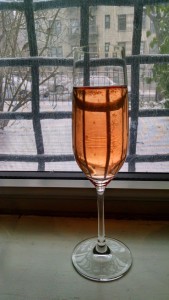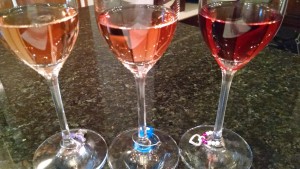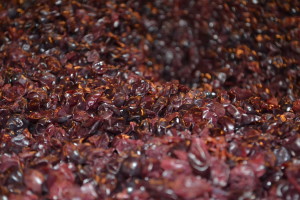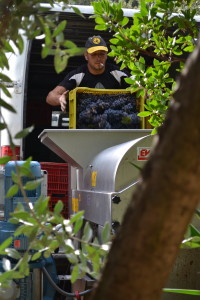http://issuu.com/tracyellenkamens/docs/drink_wisely_and_well_return_to_rou?e=9398511/35346933
Category Archives: Wine Regions
Domaine Katsaros and Ricossa offer up modern wines for modern times
Although the world of wine has a long and storied history, two recent events – dinner with Evripidis Katsaros of Domaine Katsaros and lunch with Andrea Marazia of Ricossa winery – underscored the ever-evolving nature of the industry.
Domaine Katsaros, modernity in ancient Greece
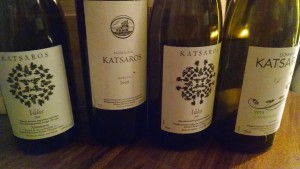 Thinking about Greece, images of the Acropolis and other ancient temples might spring to mind – crumbling pillars as a testament to a bygone civilization. But, despite this legacy of antiquity, there is a very modern bent to the winemaking currently taking place in Greece and Italy.
Thinking about Greece, images of the Acropolis and other ancient temples might spring to mind – crumbling pillars as a testament to a bygone civilization. But, despite this legacy of antiquity, there is a very modern bent to the winemaking currently taking place in Greece and Italy.
Instead of meeting Katsaros’ winemaker at a Greek establishment, the invitation promised pizza at Marta, the resident restaurant at the Martha Washington Hotel. Part of Danny Meyer’s empire (aka Union Square Hospitality Group), Marta is known for its wood-burning ovens, which turn out beautiful thin-crust pizzas and tempting grilled meats.
But, before the food was served, the journalists were given the opportunity to blind taste two wines and guess which one was the Katsaros 2015 Xinomavro barrel sample and which… was a Barolo. Like Nebbiolo — the grape responsible for Barolo (among others) — Xinomavro needs a lengthy time to fully ripen and has similarly high acidity and firm tannins. Evripidis further described Xinomavro wines as showing aromas of black fruit, rose petals, olive and tomato.
Interestingly, while the blind comparison didn’t seem to stump the participants, it did illustrate the shared characteristics of the two varieties. Yet, in the end, the Barolo’s significantly more tannic structure and less overt fruit aromas gave itself away. Meanwhile, despite its youth, the Xinomavro was rather enjoyable with its pronounced floral nose, brighter acidity and softer tannins.
For many of the guests, this was a first introduction to both Xinomavro and to Domaine Katsaros. The Domaine got its start in the early 1980s, when Evripidis’ father, Dr. Dimitrios Katsaros, purchased a small estate on the slopes of Mount Olympus. The property was initially intended as a family vacation home, but the area beckoned to him and soon he was buying additional land and planting grapevines on the 2500-foot elevation plots.
At the time, technical information on Greek grapes was non-existent, so Dimitrios looked to a grape with a proven track record: Cabernet Sauvignon. The Cabernet was followed by Merlot, which was originally intended solely as a blending partner for the estate blend. However, they quickly discovered that the grapes were of significant quality to be crafted into a single variety Merlot.
In the early days, Dimitrios made wine only for friends and family, but, by 1985, the winery became official, coinciding with Evripidis’ childhood and adolescence. Having spent his summers watching his father build up the estate, it was a natural fit for him to study bio-chemistry at Bordeaux University, followed by a degree in Viticulture and Oenology from Burgundy University.
Consequently, Evripidis knows his way around French grapes and his contribution in this regard has been the addition of Chardonnay, thanks to his belief that they would get good results from this variety. While many areas of Greece would be too hot for a grape that thrives in Burgundy’s cool climate, the northerly position of Domaine Katsaros’ provides a suitable home with a latitude and weather akin to that of Tuscany. In true French fashion, the Chardonnay is aged in French oak for several months, although Evripidis, who took over as head winemaker in 2008, admits that he prefers less wood than his father, especially in white wines.
However, despite the heavy reliance on French varieties, a subtle shift seems to be taking place, with a new interest in indigenous grapes, as evidenced by the planting of Xinomavro grapes in 2010. And, soon, they will add Robola Kefalonia, a white grape that originated on the island of Cephalonia.
Today, the family-owned winery is still the only one within Thessally’s PGI Krania, and maintains its dedication to using only estate grown fruit even though the vineyards are dispersed among 21 separate parcels. In recognition of their good stewardship of the land, the vineyards received organic certification in 1998.
Overall, the wines were very well made and showed off Evripidis’ skill as a French-trained winemaker. In this regard, although the Xinomavro/Barolo comparison was quite fun, it would be equally fascinating to taste his Merlot beside a glass of Right Bank Bordeaux.
Unfortunately, not only do people really like the Domaine Katsaros’ wines, but they (or at least the grapes that go into them) are a big hit with wild boars; nearly all of the 2014 crop was eaten by the pigs. Thus, it was with some sense of poetic justice that we eagerly devoured the meat-heavy Macellaio pizza (Sopressata, Guanciale, Pork Sausage, Mozzarella and Grana Padano) and the grilled pork loin with the wines. Thankfully, the boar were less destructive in 2015, ensuring that there will be more wine to go around for this latest vintage.
Ricossa wine, co-opting old traditions to create new trends
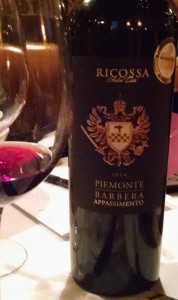 Although not nearly as ancient as ancient Greece, winemaking in Italy’s Piedmont region – home to the aforementioned Nebbiolo and hence, Barolo – dates back several centuries. Here, traditional winemaking has primarily centered on producing powerful, long-lived reds that take decades to reach their full potential. And, it seemed that such traditions were firmly entrenched.
Although not nearly as ancient as ancient Greece, winemaking in Italy’s Piedmont region – home to the aforementioned Nebbiolo and hence, Barolo – dates back several centuries. Here, traditional winemaking has primarily centered on producing powerful, long-lived reds that take decades to reach their full potential. And, it seemed that such traditions were firmly entrenched.
But, even here, things are shifting. For one, classic wine styles have been evolving since the 1980s as a decidedly different view of Barolo winemaking came to the fore, splitting producers into one of two camps — Traditionalist vs. Modernist.
More recently, in another blending of old and new, the region has co-opted the age-old tradition of drying grapes in service of a new, modern style of Barbera. The newly minted Barbera Appassimento DOC owes a debt of gratitude to Ricossa Winery, which was the brainchild behind the creation of this wine.
The company, part of the MGM Mondo del Vino group, felt that there was something missing from the Piedmontese winescape – wines made in the appasimento style – and specifically targeted the Barbera grape as the beneficiary of this process. And, after only a year of discussions with the Consorzio, this new wine was approved as of the 2014 vintage.
The appasimento style is most closely associated with Italy’s Veneto region – think Amarone della Valpolicella, but, essentially, these wines are produced from grapes that are dried in humidity-controlled, ventilated room, thereby reducing water content and concentrating aromas and flavors in the grape.
Moreover, the specific rules for the Barbera Appassimento DOC are vastly different than those of Amarone. Of note, the drying process for this new wine is limited to four to six weeks, a much shorter time frame than the four months required for Amarone production. Further, there is no wood aging permitted compared to the minimum two years of oak aging for Amarone.
Yet, despite the obvious comparison to the Veneto, the true intent was to express the Barbera grape in a alternate way rather than mimic Amarone, as evidenced by the resulting style of wine. The group was pleasantly surprised at how fresh and light the wine was, finding it to be a great expression of the grape with softer acidity and fuller body than more traditional Barbera wines. Lunch guests also tasted Ricossa’s Gavi as well as its Barbaresco 2011 and Barolo Riserva 2008, which provided a broader introduction to the winery’s portfolio.
Velenosi: Wines of Poise and Passion
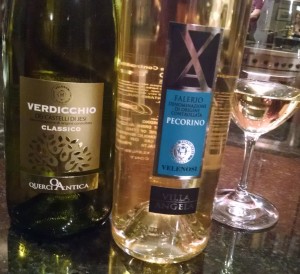 When I was first invited to meet with Angela Velenosi, owner of Velenosi Winery in Le Marche, I was intrigued by her name. Having studied Italian, the word velenosi struck an immediate cord; we had read stories in class about a character named Valentino Valentini who had first gone on a walk through the forest collecting mushrooms and making a tasty risotto with them. Unfortunately, as the tale went, “Ma…spesso i funghi sono velenosi” – but…often mushrooms are poisonous – so Valentino was brought to the Emergency Room. After leaving the hospital a few days later, our dear friend Valentino was treated to a dinner of oysters, but, as was pointed out: “Ma…spesso le ostriche sono velenose” (but…often oysters are poisonous), so Valentino was again rushed off for emergency care.
When I was first invited to meet with Angela Velenosi, owner of Velenosi Winery in Le Marche, I was intrigued by her name. Having studied Italian, the word velenosi struck an immediate cord; we had read stories in class about a character named Valentino Valentini who had first gone on a walk through the forest collecting mushrooms and making a tasty risotto with them. Unfortunately, as the tale went, “Ma…spesso i funghi sono velenosi” – but…often mushrooms are poisonous – so Valentino was brought to the Emergency Room. After leaving the hospital a few days later, our dear friend Valentino was treated to a dinner of oysters, but, as was pointed out: “Ma…spesso le ostriche sono velenose” (but…often oysters are poisonous), so Valentino was again rushed off for emergency care.
After meeting Angela Velenosi in person, I am pleased to note that, while Valentino Valentini was quite unlucky, Angela has had a much better track record with her life. This poised and passionate Italian woman has been the driving force behind her family’s wine label, which she founded in 1984 with then husband, Ercole, when she was only 20 years old. The two saw the opportunity, had a good relationship with the local wine community and, perhaps most importantly, a passion for wine. Angela admits that she had very limited knowledge and experience, but clearly had an abundance of conviction, confidence and courage.
Thirty-plus years later, it is evident that her gamble and dedication has paid off. An award winning winery (listed among Wine Spectator’s top 100 wineries in both 2012 and 2013), Velenosi is firmly established in the region today and is the second largest, family-owned estate, with 100 hectares planted in the south of the region and another 48 hectares located closer to the sea in the province of Ancona.
This same fearlessness seems to pervade everything she does. During dinner she revealed that she has run a total of 11 marathons – three of them in New York. Unfortunately, her knees have kept her from continuing this particular passion, but while, marathons are not a part of her life anymore she is still extremely active.
In addition to being a staunch supporter for her own brand, Angela is equally heartfelt about the region and currently serves as President of the Consorzio di Tutela Vini Piceni, a post she has held since 2014.
Admittedly, among Italian wines, at least in the U.S., Le Marche is much less well known, but this region, situated along Italy’s Eastern coast along the Adriatic Sea, has a lengthy history. The only plural among Italy’s 20 regions, Le Marche got its name in 1105 when three border regions were joined by the Roman Emperor Henry IV. (And, perhaps it’s a bit like New York City’s The Bronx in that it is the only region to possess an article.) Within Le Marche, the town of Ascoli dates back to 1000 BCE and was established by the Piceni tribe of warriors. It pre-dates the Romans’ rise to prominence and was known for its iron works and jewels.
Today, Le Marche is home to 5 DOCGs and 16 DOCs, featuring a diverse range of climates, depending upon topography and distance from the coast. The area features various hills and mountains; there are no flat lands to be found. The relatively small region is primarily known for its crisp, refreshing whites and its Montepulciano-based reds. Although Sangiovese features heavily in many of Le Marche’s wines, the Sangiovese in the Le Marche is a different clone than that found in Tuscany. Consequently, these wines share more similarity to those produced in Abruzzo than in Tuscany.
Velenosi produces 20 different wines, from a combination of indigenous varieties (such as Pecorino, Passerina, Verdicchio, Montepulciano, Sangiovese and Lacrima) and international grapes. In general, Angela likes wines that are both ready to drink, but also have good aging potential, a philosophy she applies to all of the wines she produces. With this mind, many of her wines are bottled in dark, heavy glass to keep the light out during the lengthy aging process. Additionally, Angela looks for clarity and purity in all of her wines. As a result, Angela’s wines are anything but poisonous. – they are elegant, well made expressions of the Le Marche terroir.
Eight of the Velenosi wines are exported to the U.S., covering a range of styles and providing an excellent introduction to the wines of Le Marche!
TASTING NOTES
Passerina Brut NV, Marche, Italy
A Charmat Method sparkling wine produced from 100% Passerina grapes, this slightly off-dry sparkler presents light aromas of peach and pear on the nose and palate. It has nice acidity, with a lovely mousse, finishing cleanly and pairing well with food.
Pecorino Villa Angela Falerio DOC Pecorino 2014, Marche, Italy
Named for the tradition of grazing sheep in the mountains, this variety stems from the Italian word pecora, which translates as sheep. The wine has notes of anise, citrus and apple on the nose. The light to medium-bodied palate offers up savory, herbal and vegetal flavors with high acidity and a slight, textural grip.
Verdicchio Querciantica Verdicchio dei Castelli di Jesi DOC Classico 2014, Marche, Italy
This wine has fresh fruit aromas of peach and almond and is more fruit-forward than the Pecorino, although it is still dry and balanced. There is bright acidity on the medium to full-bodied palate, with flavors of pear, peach and almond.
Lacrima Querciantica Lacrima di Morro d’Alba DOC 2014, Marche, Italy
An aromatic red variety, Lacrima has thins skins, resulting in a lighter-bodied red, with little to no tannins. The grape’s freshness is deliberately preserved through the use of stainless steel and no wood contact. This wine expresses its fresh raspberry, cherry and plum fruit so vibrantly with bright acidity and beautiful balance.
Brecciarolo Rosso Piceno DOC Superiore 2013, Marche, Italy
Falling within the Rosso Piceno DOC rules, the specific blend is up to the producer, with this wine being a blend of 70% Montepulciano/ 30% Sangiovese, aged in older oak for 10-12 months. The heavy reliance on Montepulciano produces a stronger, darker wine than other Rosso Piceno wines.
Ludi, Offida DOCG Rosso 2011, Marche, Italy
One of Angela’s top wines, Ludi was first produced in 1998, named for the Latin root for play – ludo – a reminder that wine is meant to be enjoyed. It is a blend of 50% Montepulciano, 30% Cabernet Sauvignon and 20% Merlot, which is aged in new French oak for 24 months. This wine offers up ripe, yet elegant, black fruit with cedar, vanilla and a hint of anise, with finely grained tannins and long length.
Roggio del Filare 2010, Rosso Piceno DOC Superiore, Marche, Italy
Velenosi’s flagship is the Roggio del Filare, literally “fire in the vineyard,” whose name stems from a poem by the Italian poet Carducci, recalling the way that the sun looks on the vines as it sets in the vineyards. This 70% Montepulciano – 30% Sangiovese blend is produced from 50+ year old vines with a long maceration on the skins and then aged in new French oak for 18 months. It is intense, powerful and structured, with beautiful, concentrated black fruit, wood and minerality on the full-bodied palate with very long length.
Visciole Selezione Cherry Wine NV, Marche, Italy
This fresh and delicate dessert wine is produced from a combination of fully-fermented Lacrima grapes to which a wild cherry syrup, known as visciole, is added, causing a second fermentation and ultimately resulting in a wine with remaining sweetness. Redolent of ripe cherries on the nose and palate, the wine is nicely balanced, with enough sugar to marry well with dessert without being cloying.
Rose dreaming on a winter’s day
Certainly, a bottle of bubbly makes any occasion special – an instant upgrade from blah to ta-dah! It can brighten days and elevate moods as evidenced on a recent vacation.
Specifically, on said vacation, we were asked to wait in the restaurant’s lounge while they found us a table for dinner. About 15 minutes later, the manager brought over two complimentary glasses of Cava for us, immediately ensuring happy guests, made even happier when we were ushered to the best table in the house only a short while later.
And, every evening at 6:00 PM, the St. Regis Bahia Beach continues the tradition of sabering a bottle of sparkling wine to mark the transition from day to night, as the sun sinks below the horizon and the coqui frogs begin their song.
Moreover, if looking at the world through rose-colored glasses brings a change in attitude, just imagine what a glass of pink-hued, sparkling wine can do for you in the middle of a dreary winter!
Thinking pink, a recent tasting brought together a beautiful range of salmons, pinks and pale reds, all bursting with bubbles and imbuing the day with beauty and brightness.
Thankfully, while a winter vacation might be just a dream, enjoying a glass of sparkling rosé wine just requires an easy trip to your local retailer. Here are a few options to get you in the mood.
Mionetto Prestige Gran Rosé (SRP: $14.00)
While not technically a Prosecco, since it is both a rosé and a blend of Raboso and Lagrein, this wine hails from the same area where Prosecco is produced. Medium salmon in color, this fresh and fruity wine offered up berry, floral and cotton candy aromas, with a slightly off-dry palate (fittingly, since it is labeled Extra Dry).
Mionetto Luxury Cuvée Sergio Rosé (SRP: $19.00)
Much darker hued than its fellow rosé from Mionetto, this deep pink wine displayed aromas of roses, cherries and strawberries on the nose, all of which persisted on the off-dry palate.
Ruffino Sparkling Rosé (SRP: $15.00)
Ruffino is a well known Tuscan producer, but they have begun to branch out to other Italian regions and recently released this sparkling wine made from the Glera grape of Prosecco fame. It has a pronounced nose of floral and red fruit (raspberry and strawberry) notes, joined by a hint of cotton candy on the slightly off-dry palate.
Cavas Hill 1877 Rosado Cava (SRP: $13.00)
A blend of Garnacha and Monastrell, this Traditional Method sparkler hails from Spain and was deep salmon in color. Notes of ripe, dark berries and a hint of earthiness dominate both the nose and palate.
Alfred Gratien Brut Classique Rosé Champagne (SRP: $65.00)
Light and ethereal, this pale hued rosé Champagne presented classic yeasty, bready/brioche notes with a touch of strawberry and minerality on the brightly acidic palate, culminating in long length.
Drinking Wisely and Well: Sangiovese Spoken Here
Miner Family Winery: The Cool Miners’ Water
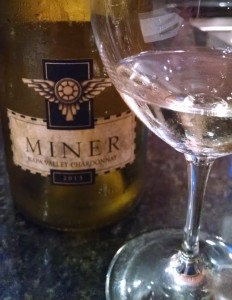
With their name proudly displayed on every bottle of wine they produce, the Miner family has made a name for themselves in Napa Valley wine. Founder Dave Miner initially launched his career in the software industry, following in the footsteps of his uncle, Robert Miner, who was among the co-founders of Oracle Corporation.
Dave continued to pursue his uncle’s passions when he took over as President of Oakville Ranch Vineyards, which Robert had established in 1989. While Oakville Ranch continues to remain in the hands of Robert’s widow, Mary Miner, Dave went on to found his own winery, Miner Family Winery in 1996, after meeting his future wife, Emily, who served as Tasting Room Manager at Oakville.
Ten years later, Dave and Emily’s efforts were duly rewarded when Miner Family Winery was honored as a Top 100 “Winery of the Year” by Wine & Spirits Magazine.
The Miner Family wines were initially crafted at a custom crush facility, but, by 1997, the pair had hired Gary Brookman on as winemaker and spent the following two years buying a building, excavating caves and releasing their first wine. In 2008, the winery was able to become energy-independent, running exclusively on self-generated solar power.
Interestingly, while they have spent considerable time and effort focused on their facility, the fruit for their wines is generally sourced from other people’s vineyards, some of which, like Hyde, Stagecoach and Garys’ Vineyard, have become extremely well known.
A wide range of wines are produced, including those from Bordeaux, Burgundy and Rhone varieties. In a fitting tribute to uncle Robert, the winery’s flagship Bordeaux-style blend, Oracle, was launched in 2004. Today, Miner Family Winery wines continue to earn critical acclaim and have been served at several White House dinners. Yet, the wines remain reasonably priced and accessible.
Miner Family Winery Chardonnay 2013, Napa Valley (CA), US, $30.00
As a high quality, well-made wine, this is an oaked Chardonnay for the haters out there. Aromas of apples, spice and pear greet the nose and persist on the dry palate; overall, it is really enjoyable with complexity and elegance.
Miner Family Winery Wild Yeast Chardonnay 2011, Napa Valley (CA), US, $50.00 Produced with only indigenous yeast cultures, this wine offers up yeasty, nutty characteristics on both the nose and palate. Despite spending 16 months in 70% new French barrels, it is well balanced with integrated oak, showing slight development and culminating in long length.
Miner Family Winery Garys’ Vineyard Pinot Noir 2012, Santa Lucia Highlands (CA), US, $60.00
Beautiful aromas of floral, cherries and a hint of herbs are displayed on the nose while rich, concentrated, ripe cherry flavors are joined by wet leaves and a kiss of oak on the palate.
Miner Family Winery Stagecoach Vineyard Cabernet Sauvignon 2012, Napa Valley (CA), US, $75.00
From the Krupp Family’s famed Stagecoach Vineyard, this wine is redolent of red and black fruits, coupled with spice notes. The full-bodied palate delivers firm tannins, with rich blackberry and spice along with long length.
Versatile Vermentino: Rolle with it!
![IMG_20151207_133046568[2]](http://itsawinederfullife.com/wp-content/uploads/2015/12/IMG_20151207_1330465682-169x300.jpg) Stuck in a rut? Instead of reaching for the same-old grape varieties, why not try a versatile Vermentino? This Mediterranean grape offers up unoaked, fresh fruit flavors with bright acidity. Masquerading under a myriad of synonyms, the grape is also known as Rolle (France’s Provence and Corsica), Favorita (Piedmont) and Pigato (Liguria).
Stuck in a rut? Instead of reaching for the same-old grape varieties, why not try a versatile Vermentino? This Mediterranean grape offers up unoaked, fresh fruit flavors with bright acidity. Masquerading under a myriad of synonyms, the grape is also known as Rolle (France’s Provence and Corsica), Favorita (Piedmont) and Pigato (Liguria).
Vermentino is also widely planted in Tuscany and is the main white variety found in Montecucco and the Maremma. These dry, white wines typically display peach and pear fruit aromas with an occasional floral or spice note.
However, Vermentino probably shines brightest on the island of Sardinia where it has earned the highest designation for quality wine: Vermentino di Gallura DOCG. It was here that the vines were initially introduced to the island from Corsica in the early 1800s. Situated on the northeast of the island, Gallura’s name translates as an area located on high ground due to its elevation. The spot is also prized for its granite soils, which provide a mineral character to the wines, while the proximity to the sea adds a note of salinity.
One of the leading wineries in the area is Vigne Surrau, which produces 300,000 bottles annually. Although they also produce wines from Cannonau and Carignano, 60% of the winery’s production is dedicated to white wines, especially from Vermentino. In this regard, they make a range of styles from the variety, including dry, sweet and sparkling. Like the people on the island (Sardinia is known for being among the top five places in the world where people live the longest), these Vermentinos have great longevity. They can easily age for 5 to 7 years due the granitic soils, and, while they lose some of their freshness similar to aged Riesling, they retain their beautiful structural elements and evolve in the bottle.
V al delle Rose Litorale Vermentino 2014, Maremma Toscana DOC, Italy
al delle Rose Litorale Vermentino 2014, Maremma Toscana DOC, Italy
With 10% Sauvignon Blanc in the blend, this wine displays a nice richness on the palate with pear and lanolin, along with fresh acidity.
La Mora Vermentino 2014, Maremma Toscana DOC, Italy Very floral nose joined by flavors of peach and pear on the round palate.
Moris Farms Vermentino 2014, IGT Toscana, Italy
Tropical in style with intense peach fruit, floral and spice notes on the nose and palate.
Massi di Mandorlaia Vermentino 2014, IGT Costa Toscana, Italy Aromas of peach, pear and mineral persist on the fresh palate with good acidity and long length.
 Marchesi de Frescobaldi Massovivo Ammiraglia Vermentino 2014 IGP Toscana, Italy
Marchesi de Frescobaldi Massovivo Ammiraglia Vermentino 2014 IGP Toscana, Italy
Having spent time on the lees, this elegant wine has a lovely waxy texture along with pear and peach flavors, culminating in long length.
Ribusieri Vermentino Chiaranotte 2014, Montecucco DOC, Italy
This wine shows ripe peach fruit with lanolin and spice, along with medium acidity.
ColleMassari Melacce 2014, Montecucco Vermentino DOC, Italy
A very fresh wine with high acidity and a pleasing palate of mineral, pear and peach notes.
ColleMassari Irisse 2013, Montecucco DOC, Italy
An 85% Vermentino – 15% Grechetto blend that spends ten months aged in large oak vessels, this wine displays aromas and flavors of smoke, citrus and mineral with an angular structure and a hint of spice in the finish.
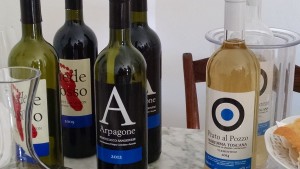 Prato al Pozzo Vermentino 2014, Maremma Toscana DOC, Italy Bright and fresh with high acidity and lots of citrus and pear along with saline and mineral characteristics.
Prato al Pozzo Vermentino 2014, Maremma Toscana DOC, Italy Bright and fresh with high acidity and lots of citrus and pear along with saline and mineral characteristics.
Tenuta I’Impostino Ballo Angelico IGP Toscano Vermentino, Italy There is almost no fruit on this wine; instead, it offers up overt mineral, chalk and salty notes on the rich palate.
Vigne Surrau Branu Vermentino di Gallura DOCG 2014, Sardegna, Italy, $18.00 Pronounced floral aromas give way to ripe peach and pear on the palate with bright acidity, richness and long length.
Vigne Surrau Sciala Vermentino di Gallura DOCG Superiore 2014, Sardegna, Italy, $25.00
Named for the Italian word for “enjoy,” this higher-end version of Vermentino offers a more restrained nose, but with more richness and texture on the medium-full palate thanks to 24 hours of skin contact and five months on the lees, along with distinct salinity and minerality.
Vigne Surrau Sole di Surrau IGT Isola dei Nuraghi Passito di Vermentino 2014, Sardegna, Italy, $N/A
This unctuous dessert wine offers up both fresh and dried apricot notes accompanied by honey and orange peel; it is beautifully balanced with bright acidity.
Sangiovese Spoken Here: Tuscany’s Montecucco
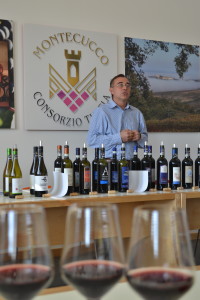 It could be the start of a bad joke: six journalists walk into a Consorzio office… wondering what in the world is Montecucco? But, instead, it was a pleasant journey that revealed another side of Sangiovese, a coterie of winemakers dedicated to their land and people passionate about wine.
It could be the start of a bad joke: six journalists walk into a Consorzio office… wondering what in the world is Montecucco? But, instead, it was a pleasant journey that revealed another side of Sangiovese, a coterie of winemakers dedicated to their land and people passionate about wine.
Situated within Italy’s Tuscany region, just south of Sienna, Montecucco abuts Morellino di Scansano and looks across the river to Brunello di Montalcino. Here, seven towns sheltered by Mt. Amiata, an extinct volcano, are making wine under the Montecucco designation.
While wine has historically been produced in the region, the denomination is quite young, having obtained recognition in 1998, thanks to the enterprising efforts of six producers. Previously, the area was known more for its polycultural approach to agriculture, with farmers growing not only grapes, but also olive groves and cereals and raising livestock, a practice which continues to this day.
But, despite its relatively recent arrival on the wine scene, Montecucco has seen significant growth in both numbers and quality and has been rewarded for its efforts. Since 2011, the denomination also sports a DOCG level wine and can boast that its yields are among the lowest in Italy at 7 tons per hectare for these top wines.
The DOC rules account for white, rosato and red wines. White wines are produced 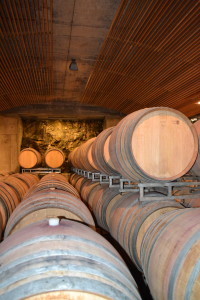 predominantly from Vermentino, with a minimum of 40% required for Montecucco Bianco DOC[1] and at least 85% of this variety for Montecucco Vermentino DOC.
predominantly from Vermentino, with a minimum of 40% required for Montecucco Bianco DOC[1] and at least 85% of this variety for Montecucco Vermentino DOC.
As elsewhere in Tuscany, Sangiovese is the grape of choice for reds. The Montecucco Rosso DOC requires a minimum of 60% Sangiovese, while the Montecucco Sangiovese DOCG must be produced with at least 90% Sangiovese. This latter wine and the Riserva also require 12 months and 24 months in wood, respectively, plus several months in bottle before release.
Given the area’s proximity to Morellino and Brunello, the wines almost beg to be compared and contrasted, in their description — more tannic than Morellino; less intense than Brunello. But, in reality, such an approach is much too limited and doesn’t provide the full picture.
Rather, the wines are truly capable of standing on their own merit and have their own distinct voice. This point was abundantly clear after we tasted through a selection of 24 wines at the consorzio office – our introduction to Montecucco. The wines were robust expressions of Sangiovese with firm tannins, notes of dried red fruit, spice and cherries with structure, complexity and power.
Moreover, as we quickly learned, as a region made up of many small producers (there are presently 70), the stories behind these wines were equally revealing. While there were differences in individual wine styles from producer to producer, a unifying declaration of a fierce devotion to quality and love for the territory was evident during our visits. To wit, 55% of the producers subscribe to organic farming.
Colle Massari: A Gentle Giant
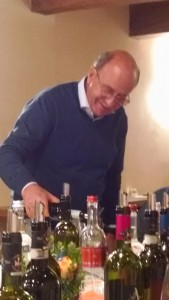 Perhaps the leading voice of the region is that of Claudio Tipa, President of the Montecucco Consorzio and owner of Colle Massari. Named for the hill on which it stands, Colle Massari is by far the largest producer in the region at 500,000 bottles per annum (of the region’s total annual production of 1.8 million bottles).
Perhaps the leading voice of the region is that of Claudio Tipa, President of the Montecucco Consorzio and owner of Colle Massari. Named for the hill on which it stands, Colle Massari is by far the largest producer in the region at 500,000 bottles per annum (of the region’s total annual production of 1.8 million bottles).
Tipa, a Tunisian-born Swiss who entered the wine industry after a successful career in telecommunications has built a portfolio of wine properties with his sister, Maria Iris, beginning with the purchase of Colle Massari in 1998.
Now also the owner of Grattamarco (in Bolgheri) and Poggio di Sotto (in Montalcino), Claudio admits that he entered the industry in a backwards manner by starting with a wine that was unknown in the market. Yet, despite this obstacle, and the allure of his other properties, his heart seems wedded to Montecucco.
Further, his commitment to Montecucco appears motivated by passion and not profit; Claudio proclaimed that, “We want to do something else – something smaller; something real. [Montecucco] is little and hidden. If you have Brunello, you can sell it. Montecucco is much harder [to sell].” In spite of Colle Massari’s relatively large size, his maintains a philosophy of staying small while keeping the quality high. His hard work and dedication have paid off, with Colle Massari earning Gambero Rosso’s Winery of the Year distinction in 2014.
Not surprisingly given his tenure and stature in the region, Claudio has served as president of the consorzio three times, but says that he won’t serve in that position again. Instead, he prefers to get the younger generation involved. In fact, he mentioned that he plans to retire at 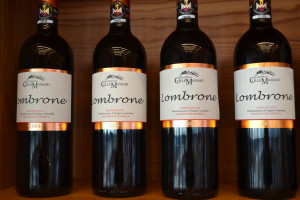 age 70. While I enjoyed the full collection of Colle Massari wines, I was particularly impressed with the Montecucco Riserva 2012, which displayed an impressive array of spice, cinnamon, black cherry, wet leaves, earth and olive notes.
age 70. While I enjoyed the full collection of Colle Massari wines, I was particularly impressed with the Montecucco Riserva 2012, which displayed an impressive array of spice, cinnamon, black cherry, wet leaves, earth and olive notes.
Perazzeta: Preserving the Past 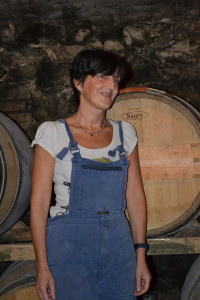 Another of the region’s early pioneers is Perazzeta. One of the founding members of the DOC, this small family business operates from a building that dates to 1400. The historic cellar was bombed during WWII because the Allies through the Germans were hiding there (they weren’t, but others were).
Another of the region’s early pioneers is Perazzeta. One of the founding members of the DOC, this small family business operates from a building that dates to 1400. The historic cellar was bombed during WWII because the Allies through the Germans were hiding there (they weren’t, but others were).
Similarly, the vineyard had been in the family for generations, providing wines for daily use. But, in 1994, the family was asked to bottle their wine by a Livorno restaurant, encouraging them to pursue a more commercial course for their wines. Today, their annual production runs 60-70,000 bottles.
In another nod to the past, the Bocci family has been working with a professor from Padua to research and identify old vines that have survived. As a result of this work, the winery’s Emma is produced from an extinct Sangiovese clone.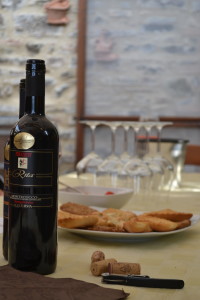
We were greeted at Perazzeta by Rita Bocci, wife of winemaker, Alessandro, who welcomed us dressed in denim overalls, underscoring the hands-on, down-to-earth nature of the people we met. More recently, they have been joined by their daughter, Sara, in the family business. Their Rita Riserva 2009 – named for both Alessandro’s wife and mother – was stunning with its beautiful development of spice, oak and cherry.
Prato al Pozzo: Yielding a Dream
 At Prato al Pozzo, we met Francesca Quiriconi, who owns the small estate with her husband, Fabio. The duo purchased the property in 2003 and have been slowly growing the estate. Fabio has served as director of two Antinori estates for many years and has always had a dream to produce his own wine.
At Prato al Pozzo, we met Francesca Quiriconi, who owns the small estate with her husband, Fabio. The duo purchased the property in 2003 and have been slowly growing the estate. Fabio has served as director of two Antinori estates for many years and has always had a dream to produce his own wine.
After ten years of waiting, they are finally building a real cellar, with construction appearing almost completed during the time of our visit. But, this dream has not come without its costs. Francesca manages the property in Fabio’s absence (he is only home on weekends) and is also responsible for taking care of their two daughters on her own.
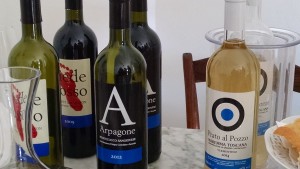 Named for a Molière character who was reluctant to spend money, their flagship wine is sourced from the initial Arpagone vineyard (1.5 hectares), which doesn’t yield very much. Although Francesca referred to this wine as a “poor cousin of Brunello,” it was really quite lovely with fresh cherries, earth, olive and mineral character. As they continue to establish themselves, they plan to grow to a maximum of 2.5 hectares and are in the process of converting to biodynamics.
Named for a Molière character who was reluctant to spend money, their flagship wine is sourced from the initial Arpagone vineyard (1.5 hectares), which doesn’t yield very much. Although Francesca referred to this wine as a “poor cousin of Brunello,” it was really quite lovely with fresh cherries, earth, olive and mineral character. As they continue to establish themselves, they plan to grow to a maximum of 2.5 hectares and are in the process of converting to biodynamics.
Poggio Mandorlo: Bringing Friends Together
Another realization of a dream, Poggio Mandorlo brought together four friends – Roberto, Felice, Giuseppe and Fabio – who wished to make their own wine. Accordingly, they came to the region in 2001, planting 30 acres of land under the direction of Consultant viticulturist, Maurizio Saettini, and initially hiring Brunello producer, Roberto Cipresso (of La Fiorita), as their consultant winemaker.
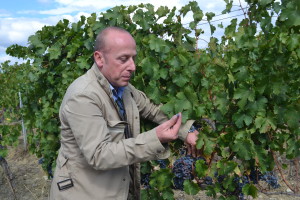 The estate sits 250 meters above sea level. Here, the mountains protect the vineyard from the Sirocco winds and stop the rain, while the good wind from the sea is able to penetrate and benefits the vines. With Sangiovese, Merlot and Cabernet Franc, the vineyard was carefully planted based on soil and exposure. Unlike Montalcino, which has no calcium in its soils, the Poggio Mandorlo estate is home to calcareous Albezza soils, similar to those found in Chianti Ruffina. The first vintage was in 2004.
The estate sits 250 meters above sea level. Here, the mountains protect the vineyard from the Sirocco winds and stop the rain, while the good wind from the sea is able to penetrate and benefits the vines. With Sangiovese, Merlot and Cabernet Franc, the vineyard was carefully planted based on soil and exposure. Unlike Montalcino, which has no calcium in its soils, the Poggio Mandorlo estate is home to calcareous Albezza soils, similar to those found in Chianti Ruffina. The first vintage was in 2004. 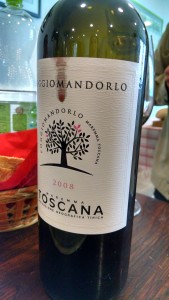
Their top wine, bearing the same name as the estate, is a blend of 70% Merlot and 30% Cabernet Franc, taking its cue from St. Emilion, despite its IGT Maremma Toscana designation. Given their north-facing exposure, the Cabernet Franc vines maintain good acidity and provide elegance to this wine, with its ripe fruit of red and black berries along with wet leaves and spice. Il Guardiano, their entry-level wine, previously qualified for Montecucco Sangiovese status, but with its 85% Sangiovese/15% Merlot blend, as of 2011 (the year of the new DOCG regulations), this wine is now labeled as IGT Toscana.
Poggio al Gello: A Labor of Love
With four hectares of grapes and five hectares of olives, Poggio al Gello 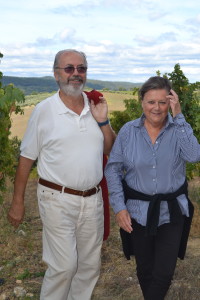 is a labor of love for a retired teacher (Alda) and engineer (Giorgio) who claim that they are continuing to work, but without the stress. The two are happy with their small size of 20,000 bottles annually and are proponents of organic agriculture.
is a labor of love for a retired teacher (Alda) and engineer (Giorgio) who claim that they are continuing to work, but without the stress. The two are happy with their small size of 20,000 bottles annually and are proponents of organic agriculture.
Recognizing that they needed schooling in the ways of wine, the couple hired the director of Col d’Orcia as their “teacher.” They note that he never tells them to do this or do that, but rather, is careful to explain to them why they should or shouldn’t do something. “He is our doctor of wine,” Alda says. Their Rosso del Gello Riserva 2011 spent two years in large oak, resulting in depth and complexity in the balanced and elegant wine.
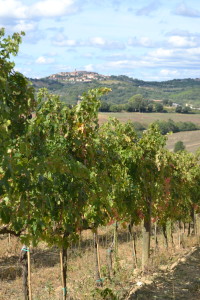 In addition to producing Montecucco wines, the estate makes two wines from ancient varieties – Pugnitello and Fogliatonda — as much as to preserve these nearly extinct varieties as because they don’t wish to be boring. Beyond wine, they also make their own olive oil. In fact, Alda seems to come alive in the olive grove, as she stops to admire the budding olives on the tree. In their spare time, he is writing a novel, while she plays the piano and recently wrote a song for their grandson.
In addition to producing Montecucco wines, the estate makes two wines from ancient varieties – Pugnitello and Fogliatonda — as much as to preserve these nearly extinct varieties as because they don’t wish to be boring. Beyond wine, they also make their own olive oil. In fact, Alda seems to come alive in the olive grove, as she stops to admire the budding olives on the tree. In their spare time, he is writing a novel, while she plays the piano and recently wrote a song for their grandson.
Tenuta l’Impostino: A Place to Stop and Rest
On a larger scale, Tenuta l’Impostino takes its name from the impostini — places where couriers would stop and change horses before heading on to their next destination during Medieval times. But, instead of moving on to the next location, the current owners fell in love with the area and decided to stay.
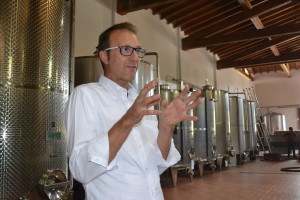 The 52 hectare property has 25 planted to vines, where a natural amphitheater provides excellent exposure. The old homestead’s restored farmhouse and stable presently serve as a restaurant and inn, respectively, providing a wonderful place for tourists to relax and recharge, while enjoying the estate’s wines.
The 52 hectare property has 25 planted to vines, where a natural amphitheater provides excellent exposure. The old homestead’s restored farmhouse and stable presently serve as a restaurant and inn, respectively, providing a wonderful place for tourists to relax and recharge, while enjoying the estate’s wines. 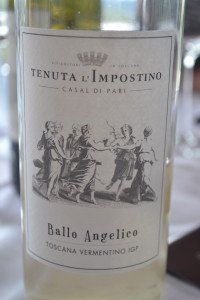
The first harvest was in 2006 and, in spite of the property’s size, the grapes continue to be hand harvested. Tenuta I’Impostino’s Vermentino, Ballo Angelico, was one of my favorite whites, with freshness, minerality and a touch of salinity. Their Montecucco Rosso 2011 was also really lovely, with cherries, earth and spice.
Parmoleto: The Family that Farms Together
As Leonardo Sodi meets us in his parking lot, he glances wistfully across the valley at Castello Banfi and Brunello territory, seemingly only a whisper away. Yet, he is resigned to his Montecucco fate and in keeping the family farm in the family.
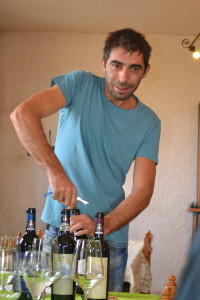 The 72 hectare estate consists of five hectares of vineyards, three hectares of olive groves and 65 hectares of cereals, along with 300 pigs and a bed-and-breakfast. The vines were mostly planted in 2000 and include just over 1 acre of Riesling.
The 72 hectare estate consists of five hectares of vineyards, three hectares of olive groves and 65 hectares of cereals, along with 300 pigs and a bed-and-breakfast. The vines were mostly planted in 2000 and include just over 1 acre of Riesling.
The Sodi family’s historic cellar is 100 years old, but his parents only starting bottling wine in 1990 and were among the six founders of the DOC. Today, they produce seven different wines, with a total annual production of 23,000 bottles. The intention is to maintain the current size of production because Leonardo is determined to keep it a family farm. If it becomes too large, it will not be a family farm.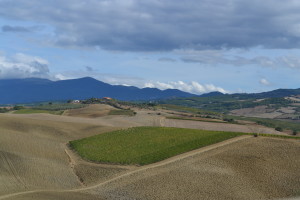
A sparkling wine and full-bodied white round out the predominantly red portfolio, but a rosato is noticeably absent because as Leonardo explains, he doesn’t like rosé. Although it needed more time to resolve its tannins, the Montecucco Sangiovese Riserva 2010 was balanced and elegant with tart cherry, spice and wood. His Sormonno, a blend of 75% Sangiovese and 25% Cabernet Sauvignon, displayed power and structure along with minerality and spice and was fondly dubbed a “Super Cucco” by fellow journalist, Dave Eckert.
Campo Nuovi: Breathing New Life into New Lands
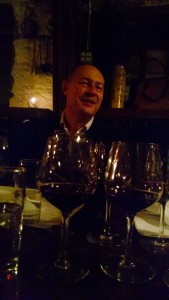 I first met Daniele Rosellini when I visited Chianti Classico in 2011; the agronomist had been instrumental in the Chianti Classico 2000 research in which the best grape varieties, clones and rootstocks were identified as part of Chianti Classico’s commitment to improving quality. During this time, Daniele and his wife, Nadia Riguccini, wished to craft their own wines, but they needed to stay outside the Chianti Classico territory to avoid a conflict of interest with his job.
I first met Daniele Rosellini when I visited Chianti Classico in 2011; the agronomist had been instrumental in the Chianti Classico 2000 research in which the best grape varieties, clones and rootstocks were identified as part of Chianti Classico’s commitment to improving quality. During this time, Daniele and his wife, Nadia Riguccini, wished to craft their own wines, but they needed to stay outside the Chianti Classico territory to avoid a conflict of interest with his job.
After much consideration, they purchased property 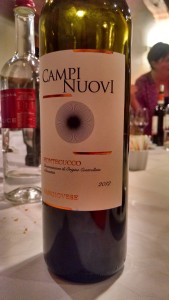 within the budding Montecucco denomination in 2000 with the goal of creating their own venture. Their land was previously referred to in historic documents as “Campi Nuovi” (New Fields), a name they kept as they thought is fitting to begin their “new life.” Today, their property is Certified organic and they are also practicing biodynamics. I didn’t have the opportunity to visit his estate during this trip, but it was a lovely surprise and pleasure to become reacquainted with him and to taste his wonderful wine. His Montecucco Rosso 2012 was powerful, concentrated and full of intense, dark red fruit, with slight notes of spice and vanilla.
within the budding Montecucco denomination in 2000 with the goal of creating their own venture. Their land was previously referred to in historic documents as “Campi Nuovi” (New Fields), a name they kept as they thought is fitting to begin their “new life.” Today, their property is Certified organic and they are also practicing biodynamics. I didn’t have the opportunity to visit his estate during this trip, but it was a lovely surprise and pleasure to become reacquainted with him and to taste his wonderful wine. His Montecucco Rosso 2012 was powerful, concentrated and full of intense, dark red fruit, with slight notes of spice and vanilla.
In Montecucco, Sangiovese speaks loudly and proudly; those tasting these wines will be rewarded with beautifully balanced, well-made wines. But, it is the voices of the people I met that linger with me still.
[1] Alternately, the Montecucco Bianco can contain a minimum of 40% Trebbiano Toscano.
Pieces of the Puzzle: Putting Together a Glass of Champagne
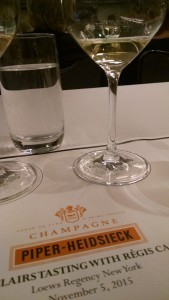 Once upon a time (also known as several years ago), we found a scrap of plastic film that read, “Assembly of Dust. Some Assembly Required.”
Once upon a time (also known as several years ago), we found a scrap of plastic film that read, “Assembly of Dust. Some Assembly Required.”
Not knowing what it was or what is meant, it was one of the strangest and most confusing things we ever found on our kitchen counter. After much scratching of our collective heads, we finally identified the scrap as having come from the wrapper of a music CD that a houseguest had opened earlier that day. (It turns out that Assembly of Dust is the name of a band).
The creation of Champagne is truly like that moment – perplexing and puzzling – with lots of assembly required. In fact, lots is an understatement as evidenced by a recent visit from winemaker Régis Camus of Champagne House, Piper-Heidsieck.
During his trip to New York, Camus offered up a unique glimpse into this creation process, known as assemblage, with a tutored vin clairs tasting. A vin clair is a still wine (not sparkling) that has been produced in anticipation of making the blend that will ultimately be bottled for the secondary fermentation; in essence, each vin clair is the equivalent of a single puzzle piece.
Within the Champagne region, there are hundreds of puzzle pieces to be considered. First, there is grape variety; the permitted grapes include Chardonnay, Pinot Noir and Pinot Meunier. Then, there are the approximately 100 different crus (top vineyards) from which the grapes are sourced. Third is a Champagne House’s Reserve wines – wines saved from previous vintages (and kept distinctly by individual vintage). And finally, there is the time that the wine is aged on its lees as the last piece of the puzzle, which is dictated in part by law (a minimum of 15 months for non-vintage and three years for vintage) and by house style, which typically exceed the minimums.
After each harvest, the winemaker and his team start with a blank canvas as the grapes are brought to the winery. Each parcel is fermented separately into wine, becoming the multitude of puzzle pieces – or vin clairs – available to the team. Their mission, which they choose to accept each year, is to taste through the individual wines and build the puzzle based upon the given vintage.
There is no printed box to follow, instead, the “picture” for these puzzle pieces comes in the shape of a bottle – the bottle of the wine produced the year before (and the year before that…). More specifically, the goal is to replicate the house style for each of the House’s wines. By achieving this goal, consumers can be sure that each and every time they buy a bottle of Piper-Heidsieck Brut NV, it will taste precisely the same.
At Camus’ tasting, we were given five different samples that had been part of the 2014 assemblage for the Piper-Heidsieck Brut NV: Chardonnay Avize Cru 2014, Pinot Noir 2015 Verzy Cru, Pinot Meunier 2014 Ecueil Cru, Chardonnay 2009 Avize Cru and Pinot Noir 2008 Verzy Cru.
As in working to piece together a visual puzzle, each vin clair provides a sought-after characteristic that helps to shape the resulting wine; each piece adding something that would be missing without it. For instance, the Chardonnay 2014 Avize Cru was particularly prized for its structure and tension as well as its freshness, fruit and minerality. Meanwhile, the older Chardonnay provided more pronounced minerality and was richer, giving some needed depth to the final blend.
In all, the 2014 assemblage contained 55% Pinot Noir, 15% Chardonnay and 30% Pinot Meunier, representing approximately 110 different puzzle pieces, inclusive of 10% Reserve wines. It’s enough to make one dizzy (and that’s not accounting for the alcohol). However, the vin clair tasting did offer some insight into this complex process and gave me a renewed respect for these master tasters.
I prefer to leave the assembly to the Chef du Cave and drink the finished product; perhaps it will sustain me as I pour over my next 1,000-piece jigsaw puzzle.
NB: At the conclusion of the formal tasting, we had the opportunity to enjoy several of Piper-Heidsieck’s Champagnes along with passed canapés. Given the informal format, I didn’t take tasting notes, but I was especially fond of the Rosé Sauvage and the prestige cuvée, Rare Millésime 2002. I may even have been willing to pose with the latter bottle’s laser cut label worn as a tiara.
A Harvest Celebration: It’s Never Too Early
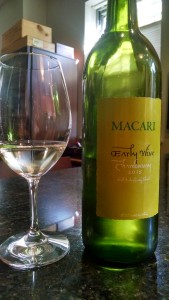 The third Thursday of November is Beaujolais Day – the day on which the new vintage of Beaujolais Nouveau is released. Georges Duboeuf, the largest producer, generally hosts a festive affair heralding the wine’s arrival on America’s shores with a bang; from chefs on motorcycles to trapeze artists to graffiti artists. This year, there wasn’t even a whimper. Instead, I received only a single email from retailer, Sherry-Lehmann to mark the occasion. I thought perhaps I had fallen off that invite list, but, in speaking with a colleague, learned that there was no party this year.
The third Thursday of November is Beaujolais Day – the day on which the new vintage of Beaujolais Nouveau is released. Georges Duboeuf, the largest producer, generally hosts a festive affair heralding the wine’s arrival on America’s shores with a bang; from chefs on motorcycles to trapeze artists to graffiti artists. This year, there wasn’t even a whimper. Instead, I received only a single email from retailer, Sherry-Lehmann to mark the occasion. I thought perhaps I had fallen off that invite list, but, in speaking with a colleague, learned that there was no party this year.
While many decry the quality (or rather the lack thereof) of Beaujolais Nouveau, I have always enjoyed the quasi-holiday and, if not the wine itself (which, in fact, I generally do), then what it stood for: a celebration of the arrival and completion of yet another harvest. Another year of toil in the soil and effort in the winery.
We can easily see the bounty of the year’s harvest in the cornucopia of fruits and vegetables in the farmer’s market. But, unlike fresh grapes (and other produce), which provide immediate gratification from vine to vendor, wine takes time to make.
Wines like Beaujolais Nouveau are the exception, going from grape to glass in just a few weeks. It may not be complex and age-worthy, nor is it meant to, rather, it is fresh and fruity and a reminder of what is to come with more time and effort… other wines from this vintage. A time to celebrate the season and give thanks for what Mother Nature has once again provided.
Without the usual Beaujolais Day hoopla, something seemed missing. But, the arrival of Macari’s Early Wine 2015 gave me my much-needed fix. The grapes for this Chardonnay wine were harvested in early September, making their way to bottle by the end of October and released during the first week of November.
On the evening before Thanksgiving, I took a moment to open up this wine and pause and reflect on my deep gratitude in anticipation of the following day’s holiday. I also took time to reflect on what was in the glass – white floral and peach aromas; slightly off-dry palate with vibrant acidity; citrus, peach and floral flavors; and a long finish.
And, more importantly, I took time to notice what the wine reflected back: the remembrance of the freshness of summer as we head into winter; the long days of toil and effort in the vineyard; the gentle care taken by Kelly Urbanik in the winery; and the promise of what is to come from the other fruits of 2015’s labor.


